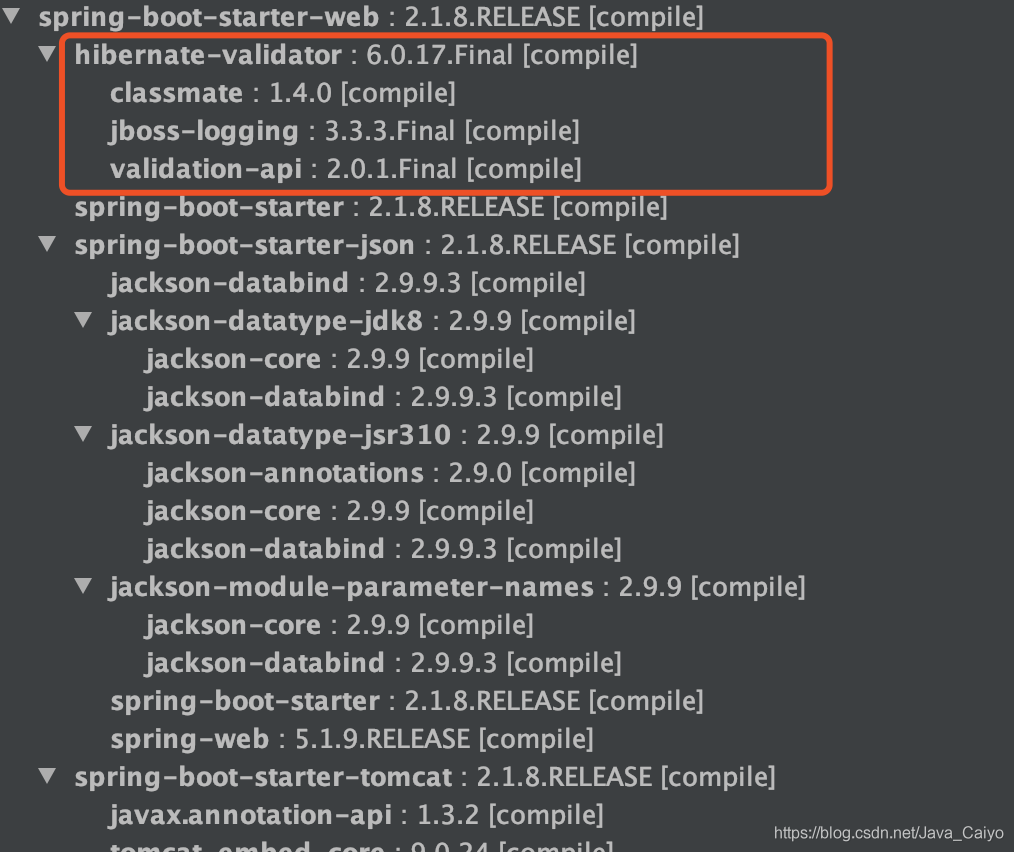Java 中高级核心知识全面解析——常用框架 (Spring 常用注解
}
2.POST 请求
@PostMapping("users") 等价于@RequestMapping(value="/users",method=RequestMethod.POST)
关于 @RequestBody 注解的使用,在下面的“前后端传值”这块会讲到。
@PostMapping("/users")public ResponseEntity<User> createUser(@Valid @RequestBody UserCreateRequest userCreateRequest) {return userRespository.save(user);}
3.PUT 请求
@PutMapping("/users/{userId}") 等价于@RequestMapping(value="/users/{userId}",method=RequestMethod.PUT)
@PutMapping("/users/{userId}")public ResponseEntity<User> updateUser(@PathVariable(value = "userId") Long userId,@Valid @RequestBody UserUpdateRequest userUpdateRequest) {......}
4.DELETE 请求
@DeleteMapping("/users/{userId}") 等价于@RequestMapping(value="/users/{userId}",method=RequestMethod.DELETE)
@DeleteMapping("/users/{userId}")public ResponseEntity deleteUser(@PathVariable(value = "userId") Long userId){......}
5.PATCH 请求
一般实际项目中,我们都是 PUT 不够用了之后才用 PATCH 请求去更新数据。
@PatchMapping("/profile")public ResponseEntity updateStudent(@RequestBody StudentUpdateRequest studentUpdateRequest) {studentRepository.updateDetail(studentUpdateRequest);return ResponseEntity.ok().build();}
四、前后端传值
掌握前后端传值的正确姿势,是你开始 CRUD 的第一步!
1.@PathVariable 和 @RequestParam
@PathVariable 用于获取路径参数, @RequestParam 用于获取查询参数。
举个简单的例子:
@GetMapping("/klasses/{klassId}/teachers")public List<Teacher> getKlassRelatedTeachers(@PathVariable("klassId") Long klassId,@RequestParam(value = "type", required = false) String type ) {...}
如果我们请求的 url 是:/klasses/{123456}/teachers?type=web
那么我们服务获取到的数据就是:klassId=123456,type=web 。
2.@RequestBody
用于读取 Request 请求(可能是 POST,PUT,DELETE,GET 请求)的 body 部分并且 Content-Type 为 application/json 格式的数据,接收到数据之后会自动将数据绑定到 Java 对象上去。系统会使用 HttpMessageConverter 或者自定义的 HttpMessageConverter 将请求的 body 中的 json 字符串转换为 java 对象。
我用一个简单的例子来给演示一下基本使用!
我们有一个注册的接口:
@PostMapping("/sign-up")public ResponseEntity signUp(@RequestBody @Valid UserRegisterRequest userRegisterRequest) {userService.save(userRegisterRequest);return ResponseEntity.ok().build();}
UserRegisterRequest 对象:
@Data@AllArgsConstructor@NoArgsConstructorpublic class UserRegisterRequest {@NotBlankprivate String userName;@NotBlankprivate String password;@FullName@NotBlankprivate String fullName;}
我们发送 post 请求到这个接口,并且 body 携带 JSON 数据:
{"userName":"coder","fullName":"shuangkou","password":"123456"}
这样我们的后端就可以直接把 json 格式的数据映射到我们的 UserRegisterRequest 类上。

需要注意的是:一个请求方法只可以有一个 @RequestBody ,但是可以有多个 @RequestParam 和 @PathVariable 。 如果你的方法必须要用两个 @RequestBody 来接受数据的话,大概率是你的数据库设计或者系统设计出问题了!
五、读取配置信息
很多时候我们需要将一些常用的配置信息比如阿里云 oss、发送短信、微信认证的相关配置信息等等放到配置文件中。
下面我们来看一下 Spring 为我们提供了哪些方式帮助我们从配置文件中读取这些配置信息。
我们的数据源 application.yml 内容如下:
wuhan2020: 2020 年初武汉爆发了新型冠状病毒,疫情严重,但是,我相信一切都会过去!武汉加油!中国 加油!
my-profile:name: Java 小菜 email: 2046136117@qq.com
library:location: 湖北武汉加油中国加油 books:
name: 天才基本法 description: 二十二岁的林朝夕在父亲确诊阿尔茨海默病这天,得知自己暗恋多年的校园男神裴之 即将出国深造的消息——对方考取的学校,恰是父亲当年为她放弃的那所。
name: 时间的秩序 description: 为什么我们记得过去,而非未来?时间“流逝”意味着什么?是我们存在于时间之 内,还是时间存在于我们之中?卡洛·罗韦利用诗意的文字,邀请我们思考这一亘古难题——时间的本质。
name: 了不起的我 description: 如何养成一个新习惯?如何让心智变得更成熟?如何拥有高质量的关系? 如何走出 人生的艰难时刻?
1.@value (常用)
使用 @Value("${property}") 读取比较简单的配置信息:
@Value("${wuhan2020}")String wuhan2020;
2.@ConfigurationProperties (常用)
通过 @ConfigurationProperties 读取配置信息并与 bean 绑定。
@Component@ConfigurationProperties(prefix = "library")class LibraryProperties {@NotEmptyprivate String location;private List<Book> books;
@Setter@Getter@ToStringstatic class Book {String name;String description;}省略 getter/setter......}
你可以像使用普通的 Spring bean 一样,将其注入到类中使用。
3.PropertySource (不常用)
@PropertySource 读取指定 properties 文件
@Component@PropertySource("classpath:website.properties")
class WebSite {@Value("${url}")private String url;
省略 getter/setter......}
六、参数校验
**数据的校验的重要性就不用说了,即使在前端对数据进行校验的情况下,我们还是要对传入后端的数据再进行一遍校验,避免用户绕过浏览器直接通过一些 HTTP 工具直接向后端请求一些
违法数据。**
JSR(Java Specification Requests) 是一套 JavaBean 参数校验的标准,它定义了很多常用的校验注解,我们可以直接将这些注解加在我们 JavaBean 的属性上面,这样就可以在需要校验的时候进行校验了,非常方便!
校验的时候我们实际用的是 Hibernate Validator 框架。Hibernate Validator 是 Hibernate 团队最初的数据校验框架,Hibernate Validator 4.x 是 Bean Validation 1.0(JSR 303)的参考实现,Hibernate Validator 5.x 是 Bean Validation 1.1(JSR 349)的参考实现,目前最新版的 Hibernate Validator 6.x 是 Bean Validation 2.0(JSR 380)的参考实现。
SpringBoot 项目的 spring-boot-starter-web 依赖中已经有 hibernate-validator 包,不需要引用相关依赖。如下图所示(通过 idea 插件—Maven Helper 生成):

需要注意的是: 所有的注解,推荐使用 JSR 注解,即
javax.validation.constraints,而不是org.hibernate.validator.constraints
1. 一些常用的字段验证的注解
@NotEmpty被注释的字符串的不能为 null 也不能为空@NotBlank被注释的字符串非 null,并且必须包含一个非空白字符@Null被注释的元素必须为 null@NotNull被注释的元素必须不为 null@AssertTrue被注释的元素必须为 true@AssertFalse被注释的元素必须为 false@Pattern(regex=,flag=)被注释的元素必须符合指定的正则表达式@Email被注释的元素必须是 Email 格式。@Min(value)被注释的元素必须是一个数字,其值必须大于等于指定的最小值@Max(value)被注释的元素必须是一个数字,其值必须小于等于指定的最大值@DecimalMin(value)被注释的元素必须是一个数字,其值必须大于等于指定的最小值@DecimalMax(value)被注释的元素必须是一个数字,其值必须小于等于指定的最大值@Size(max=, min=)被注释的元素的大小必须在指定的范围内@Digits (integer, fraction)被注释的元素必须是一个数字,其值必须在可接受的范围内@Past被注释的元素必须是一个过去的日期@Future被注释的元素必须是一个将来的日期......
2.验证请求体(RequestBody)
@Data@AllArgsConstructor@NoArgsConstructorpublic class Person {
@NotNull(message = "classId 不能为空")private String classId;
@Size(max = 33)@NotNull(message = "name 不能为空")private String name;
@Pattern(regexp = "((^Man|^UGM$))", message = "sex 值不在可选范围")@NotNull(message = "sex 不能为空")private String sex;
@Email(message = "email 格式不正确")@NotNull(message = "email 不能为空")private String email;}
我们在需要验证的参数上加上了 @Valid 注解,如果验证失败,它将抛出MethodArgumentNotValidException 。
@RestController@RequestMapping("/api")public class PersonController {@PostMapping("/person")public ResponseEntity<Person> getPerson(@RequestBody @Valid Person person) {return ResponseEntity.ok().body(person);}}
3.验证请求参数(Path Variables 和 Request Parameters)
一定一定不要忘记在类上加上 Validated 注解了,这个参数可以告诉 Spring 去校验方法参数。
@RestController@RequestMapping("/api")@Validatedpublic class PersonController {
@GetMapping("/person/{id}")public ResponseEntity<Integer> getPersonByID(@Valid @PathVariable("id") @Max(value = 5,message = "超过 id 的范围了") Integer id) {return ResponseEntity.ok().body(id);}}
七、全局处理 Controller 层异常
介绍一下我们 Spring 项目必备的全局处理 Controller 层异常。
相关注解:
@ControllerAdvice:注解定义全局异常处理类@ExceptionHandler:注解声明异常处理方法
如何使用呢?拿我们在第 5 节参数校验这块来举例子。如果方法参数不对的话就会抛出 MethodArgumentNotValidException ,我们来处理这个异常。
@ControllerAdvice@ResponseBodypublic class GlobalExceptionHandler {
/**
请求参数异常处理*/@ExceptionHandler(MethodArgumentNotValidException.class)public ResponseEntity<?> handleMethodArgumentNotValidException(MethodArgumentNotValidException ex, HttpServletRequest request) {......}}
八、JPA 相关
1.创建表
@Entity 声明一个类对应一个数据库实体。
@Table 设置表明
@Entity@Table(name = "role")public class Role {@Id@GeneratedValue(strategy = GenerationType.IDENTITY)private Long id;private String name;private String description;省略 getter/setter......}
2.创建主键
@Id:声明一个字段为主键。
使用 @Id 声明之后,我们还需要定义主键的生成策略。我们可以使用 @GeneratedValue 指定主键生成策略。
1.通过 @GeneratedValue 直接使用 JPA 内置提供的四种主键生成策略来指定主键生成策略。
@Id@GeneratedValue(strategy = GenerationType.IDENTITY)private Long id;
JPA 使用枚举定义了 4 中常见的主键生成策略,如下:
public enum GenerationType {/**
使用一个特定的数据库表格来保存主键
持久化引擎通过关系数据库的一张特定的表格来生成主键,*/TABLE,
/***在某些数据库中,不支持主键自增长,比如 Oracle、PostgreSQL 其提供了一种叫做"序列 (sequence)"的机制生成主键*/SEQUENCE,
/**
主键自增长*/IDENTITY,
/***把主键生成策略交给持久化引擎(persistence engine),*持久化引擎会根据数据库在以上三种主键生成 策略中选择其中一种*/AUTO
}
@GeneratedValue 注解默认使用的策略是 GenerationType.AUTO
public @interface GeneratedValue {
GenerationType strategy() default AUTO;String generator() default "";}
一般使用 MySQL 数据库的话,使用 GenerationType.IDENTITY 策略比较普遍一点(分布式系统的话需要另外考虑使用分布式 ID)。
2.通过 @GenericGenerator 声明一个主键策略,然后 @GeneratedValue 使用这个策略
@Id@GeneratedValue(generator = "IdentityIdGenerator")@GenericGenerator(name = "IdentityIdGenerator", strategy = "identity")private Long id;
等价于:
@Id@GeneratedValue(strategy = GenerationType.IDENTITY)private Long id;
jpa 提供的主键生成策略有如下几种:
public class DefaultIdentifierGeneratorFactoryimplements MutableIdentifierGeneratorFactory, Serializable,ServiceRegistryAwareService {
@SuppressWarnings("deprecation")public DefaultIdentifierGeneratorFactory() {register( "uuid2", UUIDGenerator.class );register( "guid", GUIDGenerator.class ); // can be done with UUIDGenerator + strategyregister( "uuid", UUIDHexGenerator.class ); // "deprecated" for new useregister( "uuid.hex", UUIDHexGenerator.class ); // uuid.hex is deprecatedregister( "assigned", Assigned.class );register( "identity", IdentityGenerator.class );register( "select", SelectGenerator.class );register( "sequence", SequenceStyleGenerator.class );register( "seqhilo", SequenceHiLoGenerator.class );register( "increment", IncrementGenerator.class );register( "foreign", ForeignGenerator.class );register( "sequence-identity", SequenceIdentityGenerator.class );register( "enhanced-sequence", SequenceStyleGenerator.class );register( "enhanced-table", TableGenerator.class );}
public void register(String strategy, Class generatorClass) {LOG.debugf( "Registering IdentifierGenerator strategy [%s] -> [%s]", strategy, generatorClass.getName() );final Class previous = generatorStrategyToClassNameMap.put( strategy, generatorClass );if ( previous != null ) {LOG.debugf( " - overriding [%s]", previous.getName() );}}}
3.设置字段类型
@Column 声明字段。
示例:
设置属性 userName 对应的数据库字段名为 user_name,长度为 32,非空
@Column(name = "user_name", nullable = false, length=32)private String userName;
设置字段类型并且加默认值,这个还是挺常用的。
Column(columnDefinition = "tinyint(1) default 1")private Boolean enabled;
4.指定不持久化特定字段
@Transient:声明不需要与数据库映射的字段,在保存的时候不需要保存进数据库 。
如果我们想让 secrect 这个字段不被持久化,可以使用 @Transient 关键字声明。
Entity(name="USER")public class User {
......@Transientprivate String secrect; // not persistent because of @Transient}
除了 @Transient 关键字声明, 还可以采用下面几种方法:
static String secrect; // not persistent because of staticfinal String secrect = “Satish”; // not persistent because of finaltransient String secrect; // not persistent because of transient
一般使用注解的方式比较多。
5.声明大字段
@Lob :声明某个字段为大字段。
@Lobprivate String content;
更详细的声明:
@Lob//指定 Lob 类型数据的获取策略, FetchType.EAGER 表示非延迟 加载,而 FetchType. LAZY 表示延迟加载 ;@Basic(fetch = FetchType.EAGER)//columnDefinition 属性指定数据表对应的 Lob 字段类型 @Column(name = "content", columnDefinition = "LONGTEXT NOT NULL")private String content;
6.创建枚举类型的字段
可以使用枚举类型的字段,不过枚举字段要用 @Enumerated 注解修饰。
public enum Gender {MALE("男性"),FEMALE("女性");
private String value;Gender(String str){value=str;}}
@Entity @Table(name = "role")public class Role {@Id@GeneratedValue(strategy = GenerationType.IDENTITY)private Long id;private String name;private String description;@Enumerated(EnumType.STRING)private Gender gender;省略 getter/setter......}
数据库里面对应存储的是 MAIL/FEMAIL。
7.增加审计功能
只要继承了 AbstractAuditBase 的类都会默认加上下面四个字段。
@Data@AllArgsConstructor@NoArgsConstructor@MappedSuperclass@EntityListeners(value = AuditingEntityListener.class)public abstract class AbstractAuditBase {@CreatedDate@Column(updatable = false)@JsonIgnoreprivate Instant createdAt;












评论